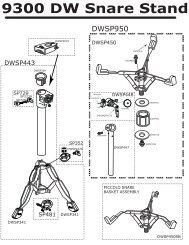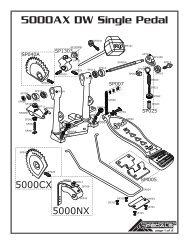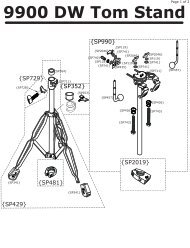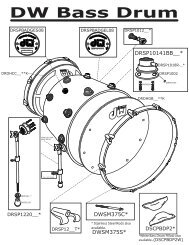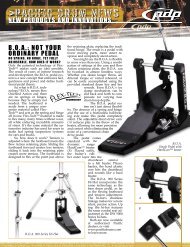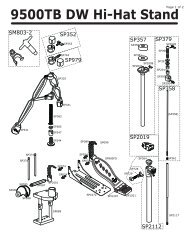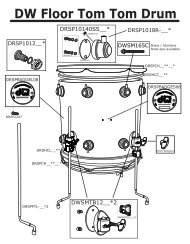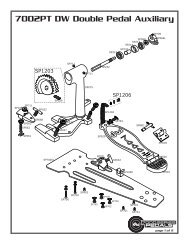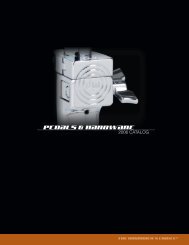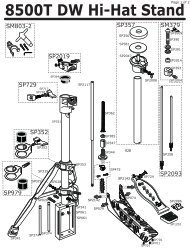Create successful ePaper yourself
Turn your PDF publications into a flip-book with our unique Google optimized e-Paper software.
is just right for shell making. It’s an art<br />
form that John and Shon have dialed-in<br />
over these many years. In speaking with<br />
both craftsmen, HVX’s story unfolds with<br />
colorful clarity.<br />
John Good: This program can only be<br />
fully understood if you understand veneer.<br />
Veneer’s attributes are as follows: no matter<br />
what kind of wood, when it’s cut into a<br />
veneer, if it has a long grain (horizontal),<br />
it’s going to have a high timbre (pitch).<br />
If it’s short grain (vertical), it’ll have a<br />
lower timbre. When you combine them<br />
in various configurations, varied sound<br />
qualities are achieved.<br />
Rich M: Does this also affect the strength<br />
of the shell?<br />
JG: Absolutely, that’s why we have to<br />
cross-laminate, or the shells would fold<br />
up like a hat box. Look at this piece of<br />
long-grain veneer (he holds out a piece<br />
of maple veneer across my fingertip). It’s<br />
only 1/36th of an inch thick and it hardly<br />
bends on your hand, you can see the<br />
strength here. Now watch as we place<br />
the same thickness with a vertical grain, it<br />
bends over your hand easily. Also, every<br />
piece of wood has a musical note value<br />
(as I held the horizontal wood veneer,<br />
John bent it and as it tightened, the pitch<br />
raised, as opposed to the vertical grain that<br />
was already much lower due to the short<br />
grain orientation. Now, I have one more<br />
piece, a 45° diagonal cut veneer (when<br />
placed on my hand, it bent diagonally).<br />
So, no matter what type of wood is used,<br />
the important factors are the direction and<br />
orientation of the grain when assembling a<br />
shell. Understanding this much will help<br />
paint a clearer picture of the path to HVX.<br />
RM: So, the importance of grain direction<br />
and how the veneers are layered gives<br />
you not only the shell’s sound potential,<br />
but also gives you control over the shell’s<br />
strength. Fascinating! Touch briefly on<br />
your early experience with timbre. Also,<br />
your familiarity with maple and how it<br />
led you to experimenting with the other<br />
woods you employ today.<br />
JG: Well, Curly Maple is mainly long grain,<br />
but has a predominant figure of vertical<br />
grain, as well, so when we used it as<br />
the outside veneer, the pitch of the drum<br />
was almost always lower. This bothered<br />
me, so Shon and I thought, “What if we<br />
turned maple vertical?” When we did<br />
that, it became the starting point for the<br />
VLT shell. This really began to make sense<br />
when we started combining wood types<br />
as exotic veneers, turning veneer vertical<br />
and then book-matching (mirror-imaging)<br />
the sheets. It was then that the rest of the<br />
grain orientation world opened up. We<br />
also found out that by turning the wood<br />
vertical around the shell, the shell’s pitch<br />
remained very, very low and that offered<br />
up a wider range of woods as shell-making<br />
materials. These days, probably more than<br />
50% of our exotic woods are vertical grain.<br />
RM: What about the diagonal wood grain?<br />
How did you utilize that?<br />
JG: We decided to try layering the diagonal<br />
veneer in an ‘X’ pattern, with the outside<br />
sheet in one direction, then the next one in<br />
the opposite direction. We found out that<br />
the pitch went down even lower! So, as we<br />
were progressing with our experimentation<br />
with grain direction, we were getting<br />
lower, deeper sounding drums. Then, we<br />
thought, “How can we make an ‘X’ shell<br />
even lower?” We thought to place two<br />
vertical plies in the middle of the ‘X’s and<br />
it proved our hypothesis by bringing the<br />
pitch down even more. That experiment<br />
became a shell we now call VLX. That’s<br />
used for floor toms, and for bass drums<br />
we add one or two more vertical plies in<br />
there and that becomes VLX Plus. With<br />
four vertical plies in a bass drum, you have<br />
to be careful because you can kill small<br />
animals with the low, subsonic frequency<br />
generated by that drum!<br />
RM: I’m sure there are a lot of drummers<br />
reading this right now with a big smile.<br />
Who doesn’t want a bass drum with that<br />
kind of low-end punch?!<br />
JG: Yes! This brings us to Performance<br />
Series HVX shells. We knew that our<br />
production kits wouldn’t be Timbre<br />
Matched, so we decided to have the grain<br />
technology do the work for us. When we<br />
decided to try putting that diagonal ply as<br />
the last outer and inner ply of a standard<br />
shell with alternating horizontal and<br />
vertical plies, we wound up stabilizing the<br />
vibration of the drum. We also found a<br />
consistency with tone and timbre between<br />
shells within the same size diameter. This<br />
process led us to create something we’d<br />
never made before: a medium-to-lowpitched<br />
drum with tremendous consistency<br />
and uncompromised shell integrity.<br />
Shon Smith: With the ‘X’ ply added, we<br />
didn’t need to add the reinforcement<br />
hoops either. The diagonal ply gave it the<br />
strength needed by pushing back on itself.<br />
RM: So, this ultimately saves man-hours<br />
by avoiding the shell selection process,<br />
thus making it a very efficient production<br />
item?<br />
JG: Indeed. Shon and I had never really<br />
done production-style drums until HVX.<br />
It really is the perfect recipe for our<br />
Performance Series kits and artists are<br />
going crazy for the sound of these drums.<br />
It makes sense because they have a nice<br />
tuning range. You can tune these drums<br />
low because of the ‘X’ factor within the<br />
plies, and we’ve found that because<br />
there are no reinforcement hoops, there’s<br />
yet another little advantage to the lower<br />
frequency range because reinforcement<br />
hoops raise the pitch ever so slightly.<br />
They’re also really versatile. We’ve had<br />
very positive feedback from Rock guys,<br />
Gospel drummers, Country drummers,<br />
every style of music! In fact, when you<br />
buy a Performance Series kit, you get a<br />
demo of John “JR” Robinson playing the<br />
drums in various styles, so you really get<br />
to hear them properly, as played by one of<br />
the world’s most recorded drummers.<br />
RM: It was always assumed that a drum’s<br />
sonic range had more to do with the<br />
thickness or mass of the shell and you have<br />
both proven that that’s not necessarily the<br />
case. Do you feel like you’re toying with<br />
physics?<br />
SS: That’s what we thought too! But after<br />
years of work with grain orientation, we’re,<br />
in essence, defying Mother Nature. This<br />
is just the tip of the iceberg. There’s a lot<br />
more we can do, and we’re having a blast<br />
doing it!<br />
EDGE 10 ||| DWDRUMS.COM 57



